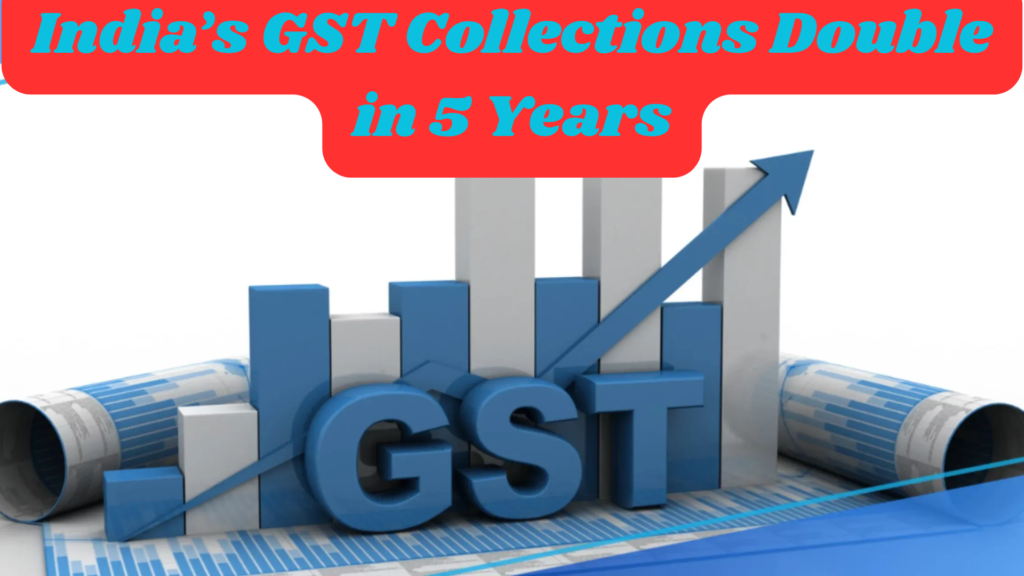

India’s GST Collections Double in 5 Years: A Landmark in Fiscal Growth and Tax Reform
India’s Goods and Services Tax (GST) regime has reached an impressive milestone in the fiscal year 2024-25, with total gross collections soaring to an all-time high of ₹22.08 lakh crore. This phenomenal rise marks a twofold increase from the ₹11.37 lakh crore collected in FY 2020-21, reinforcing the effectiveness and maturity of India’s indirect tax reform. As the GST system nears its eighth anniversary, it’s evident that this singular tax overhaul has not only streamlined the tax structure but also played a vital role in augmenting the nation’s fiscal strength.
Also Read; Mumbai Real Estate 2025; Investment, Growth & Future Outlook
GST Collections Hit Record High in FY 2024-25;India’s GST Collections
According to government data released recently, the monthly GST collections averaged ₹1.84 lakh crore in FY25, significantly up from ₹1.68 lakh crore in FY24 and ₹1.51 lakh crore in FY22. The growth trajectory reflects both improved compliance and broadening of the tax base. This fiscal year’s record-breaking performance includes a staggering ₹2.37 lakh crore collected in April 2025 — the highest ever in a single month — followed by ₹2.01 lakh crore in May 2025. The June data, yet to be released, is anticipated to reinforce this positive trend.
A Growing Taxpayer Base and Transparent Compliance
One of the primary drivers behind this surge in GST revenue is the exponential rise in the number of registered taxpayers. Since the introduction of GST in July 2017, the taxpayer base has grown from 65 lakh to over 1.51 crore in just eight years. This expansion not only highlights increased formalization of the economy but also underlines the ease of registration and compliance under the revamped tax system.
The government’s sustained efforts in digitalization, e-invoicing, and data analytics have significantly improved tax collection efficiency and minimized evasion. By integrating technologies like AI and real-time invoice matching, GSTN (Goods and Services Tax Network) has enhanced transparency, thus encouraging voluntary compliance among businesses.
GST’s Role in Streamlining India’s Indirect Tax System;India’s GST Collections
Implemented on July 1, 2017, GST replaced a complex web of 17 state and central taxes and 13 cesses with a unified five-tier tax structure. This reform not only reduced cascading taxes but also simplified the tax regime for businesses across sectors. The simplification led to improved logistics efficiency, reduced compliance costs, and better inter-state trade facilitation.
As the system approaches its eighth anniversary, the success of GST lies in its ability to evolve continually. Policy refinements, improved rate rationalization, and responsive administrative measures have helped GST emerge as a cornerstone of India’s indirect taxation framework.
Economic Implications and Future Outlook. India’s GST Collections
The doubling of GST revenues over five years comes as a strong signal of India’s economic resilience and tax buoyancy, even amidst global challenges. In FY 2023-24, gross GST collections stood at ₹20.18 lakh crore, while FY 2022-23 recorded ₹18.08 lakh crore. Compared to the ₹11.37 lakh crore of FY 2021-22 — when the monthly average was just ₹95,000 crore — the leap to ₹1.84 lakh crore per month in FY25 is a clear indication of the economy’s upward momentum.
Experts believe this growth will continue, driven by expanding consumption, increased digitization, and improved tax administration. Moreover, with a push towards including petroleum products and real estate under the GST ambit, the tax base could widen further in the coming years.
Also Read; शून्य निवेश; बिजनेस आइडिया और निष्पादन रणनीति रणनीति
Conclusion; India’s GST Collections
The doubling of GST collections in just five years marks a significant achievement for the Indian economy and underscores the long-term vision behind the tax reform. With ₹22.08 lakh crore collected in FY 2024-25, GST has proven to be not just a fiscal tool but a transformative force in reshaping India’s economic architecture. As GST completes eight years in July 2025, the journey so far reflects strong revenue performance, growing compliance, and increased taxpayer trust.
Looking ahead, continuous policy innovation, stakeholder engagement, and digital empowerment will be crucial to sustain this growth trajectory. For policymakers, businesses, and investors, GST’s success story is a testament to what coordinated reform and technology-driven governance can achieve in a developing economy.



